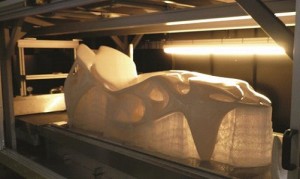Stereolithography, or SLA for short, is an additive manufacturing process (more commonly known as 3D printing) chiefly used for rapid construction of prototypes.
SLA involves a laser, a vat of liquid resin and a digital 3D model of an item you wish to create – nothing more.
Step-by-step, the process basically looks like this:
- The whole thing starts with creating a digital 3D model of a piece you want to manufacture.
- This 3D model is then converted into an STL file and is “sliced” into a set of two-dimensional layers – basically cross-sections of the model.
- A laser is used to trace out and cure these layers on the surface of a pool of a liquid resin.
- The cured layer of resin is lowered just below the surface of the liquid resin and the process is repeated until the model is complete.
- The model is then taken from the liquid resin vat, cleaned and is placed into a UV oven for further curing. This is done to speed up the process, since when the piece is cured by approximately 20%, it’s firm enough to take from the vat, and blasting it in an oven is naturally faster than having a laser cure it a square millimeter at a time.
Final tuning of the object may also include removal of the supports needed for the construction of the object.
The principle of the process is basically the same for all companies that offer SLA services. What differs is mostly the materials used (and no less important – the amount of detail the SLA device can make). If the resin is thicker – then it’s easier to cure, but its hydro-mechanical properties may suffer. One process may use a “stronger” photoinitiator. The process will take less time, but the product life may suffer due to ambient light.
The similarity of the technological process also means that you can pretty much use any raw material in any SLA machine – provided you set it up right.
All of this means that the SLA process allows you to create prototypes of pretty much any complexity fairly quickly and easily (oh, and things that you get out of a SLA 3D printer have a smooth, smooth surface).
Of course, the time it takes to create a model depends on many variables – size, equipment used, and so on – but it’s much, much faster than most alternatives. SLA lets you create a lot of prototypes, fast, and for low cost, allowing you to detect design faults and make the production process much easier and controllable.
However, stereolithography is not without faults. It’s not really suited for anything save concept models or master patterns for other prototyping methods. The main problem is that the parts produced using the SLA process end up being much weaker than most engineering-grade resins, so your prototype is limited only to light functional testing. Also, the prototype, being made from UV-curable resin, will become brittle if exposed to sun-light for too long.
To sum up, stereolithography is based on drawing a cross-section of your detail on a surface of a vat full of resin with a laser. It lets you create concept models or master patterns quickly and easily – but it’s not ideal for anything else: the prototype ends up being comparatively weak and can turn to ashes the second it sees the sun.


Comments are closed, but trackbacks and pingbacks are open.